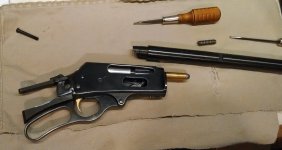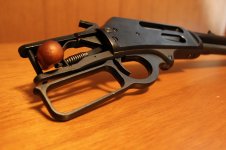This is kinda weird. I took my recently purchased, circa 1978, Marlin 336C to a gunsmith to get it cleaned and lubed. When I got it back I noticed that half the trigger plate was off-color, brownish like; the half closest to the breech. On top of that, someone long ago had taken something sharp and carved their name onto the trigger plate. The Bubba form of ID? Then, it looks like someone else tried to scratch it out. Looks like crappy kid penmanship, and a crappier attempt at erasing. What I can't figure out is what the brown color is. I did take some gun oil and 4/0 steel wool and gave it a rub-down. When I wiped it off I got brown residue on the cloth. I don't think it's rust. It's only on the trigger plate, nothing on the receiver where the trigger plate slots in. In a corner of the plate is the original finish, then it switches to that brown color.
View attachment 104527
View attachment 104528
Name carving image in on top. Brown color runs to where the lever screw hole is, and then normal finish to the other end of the plate, is image on bottom.
I never even noticed this until after I got the rifle back from getting cleaned and lubed.
I've also posted this on the Marlin Owners forum. Posting here to hit up as many resources as possible.
I am befuddled, to say the least! Thanks for any insight.
View attachment 104527
View attachment 104528
Name carving image in on top. Brown color runs to where the lever screw hole is, and then normal finish to the other end of the plate, is image on bottom.
I never even noticed this until after I got the rifle back from getting cleaned and lubed.
I've also posted this on the Marlin Owners forum. Posting here to hit up as many resources as possible.
I am befuddled, to say the least! Thanks for any insight.
Last edited:


